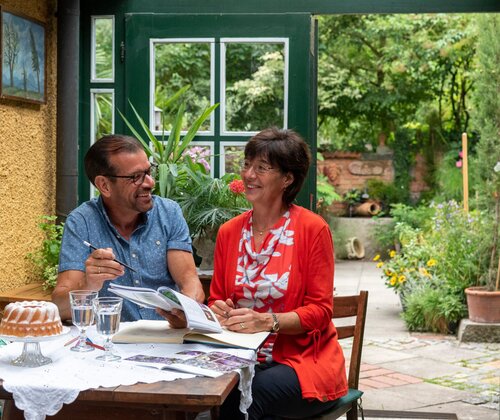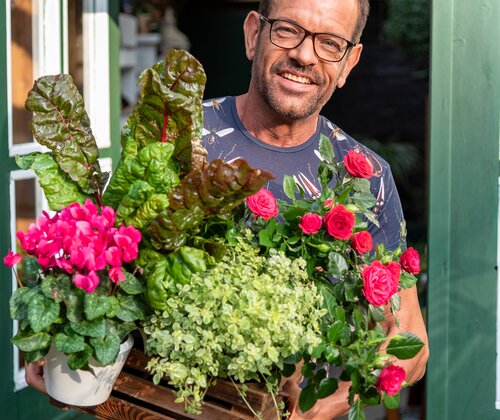
Multi-knowledge: Barbara's top ten pond care tips!
To maintain the beauty and natural clarity of a pond, nature is often your best ally! Without using any chemicals, you can create a healthy balance in the pond that not only improves the water quality, but also promotes a natural habitat for animals and plants. Multikraft expert Barbara Enengel shares her tips on pond care with you.

A pond is not only a real eye-catcher and a refreshment in the garden, it is a small ecosystem in its own right that deserves our care and attention. Instead of resorting to chemical additives, you can rely on the following natural methods for a healthy and balanced pond life.
A pond is not only a real eye-catcher and a refreshment in the garden, it is a small ecosystem in its own right that deserves our care and attention. Instead of resorting to chemical additives, you can rely on the following natural methods for a healthy and balanced pond life.
Barbara's top ten pond care tips:
1. Regular cleaning: Regularly remove leaves and algae from the surface of the water. This will prevent them from sinking and turning into nutrient-rich sediment, which in turn would accelerate algae growth.
2. Consistent filter maintenance: Filters - if present - should be regularly maintained and cleaned according to the manufacturer's instructions. This is the only way to ensure reliable filtration of the water.
3. Plant management: Cut back aquatic plants after strong growth in early summer and especially in autumn before they die and start to rot in the water. Avoid excessive surface growth and remove unwelcome invasive species such as water hyacinth and waterweed.
4. Good oxygen supply: moving water absorbs more oxygen. So create a gentle current - for example with a pump - or create a small stream or waterfall through which the water flows into the pond and is thus enriched with the necessary oxygen.
5. Adequate fish feeding: Less is more! Only feed your fish in moderation to prevent leftover food from floating in the water and polluting it. In general, fish stocking brings a lot of nutrients into the pond, which leads to increased algae growth.
6. Use a pond vacuum cleaner: Like the mopping robot in the home, a pond vacuum cleaner is also a practical invention for pond maintenance. It removes sludge and deposits from the bottom of the pond and prevents them from starting to rot.
4. Good oxygen supply: moving water absorbs more oxygen. So create a gentle current - for example with a pump - or create a small stream or waterfall through which the water flows into the pond and is thus enriched with the necessary oxygen.
5. Adequate fish feeding: Less is more! Only feed your fish in moderation to prevent leftover food from floating in the water and polluting it. In general, fish stocking brings a lot of nutrients into the pond, which leads to increased algae growth.
6. Use a pond vacuum cleaner: Like the mopping robot in the home, a pond vacuum cleaner is also a practical invention for pond maintenance. It removes sludge and deposits from the bottom of the pond and prevents them from starting to rot.
7. Cover in the autumn: To prevent a lot of leaves from entering the pond in the autumn, it is worth stretching a fine-mesh net over the entire pond.
8. Sun protection for the pond: High water temperatures promote algae growth. Adequate shading of the water (e.g. by aquatic plants such as water lilies, duckweed, etc.) naturally prevents the water temperature from rising and unwanted algae from spreading.
9. Water-friendly sun cream: Conventional sun cream contains ingredients that can affect the ecosystem of your oasis. Choose a sun cream that does not pose a risk to aquatic organisms (e.g. the bioemsan sun cream bioemsan sun cream SPF 30) or take a thorough shower before bathing in the pond.
10. Natural pond care with Multikraft Pond Clear!

Multi-knowledge - Barbara's effective tips for every home
Discover the best advice from our expert Barbara Enengel for a sustainable home and a flourishing garden in our blog series "Multiwissen - Barbaras effektive Tipps für jedes Zuhause". Whether it's about cleaning your living space ecologically or transforming your garden into a blooming oasis, Barbara's tips will enrich your everyday life. Stay tuned for inspiring stories and smart life hacks! Barbara Enengel studied agriculture at the University of Natural Resources and Life Sciences in Vienna. She is interested in natural cycles and ecological relationships in nature and in the garden. She is particularly interested in a diverse and healthy habitat for humans, animals and plants, a principle that she passionately realises in her beautifully landscaped and ecologically managed garden.

Anyone entering Karl Ploberger's garden in Seewalchen is in a different world: lush nature that is only "tamed" in some areas and an enormous variety that reflects the credo of Austria's most famous natural garden ambassador: "No matter what you do, always draw on the wide range of plants. That's what ultimately turns a green oasis into a paradise," says Ploberger with a sparkle in his eye.

Soil is the basis of all horticultural work. It is more than just the soil beneath our feet - it is a living ecosystem that forms the basis for the growth of healthy plants. On a small and large scale, in the garden and in the field. Here you can find out how to determine the type of soil in your garden, what humus is all about and how you can increase the humus content in your soil with the help of simple measures.


